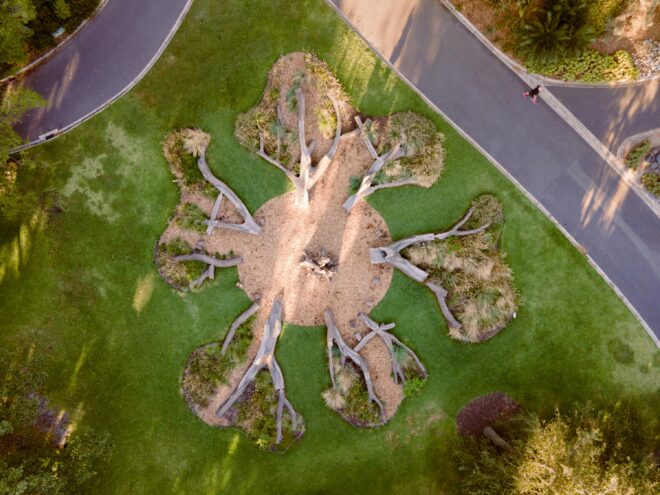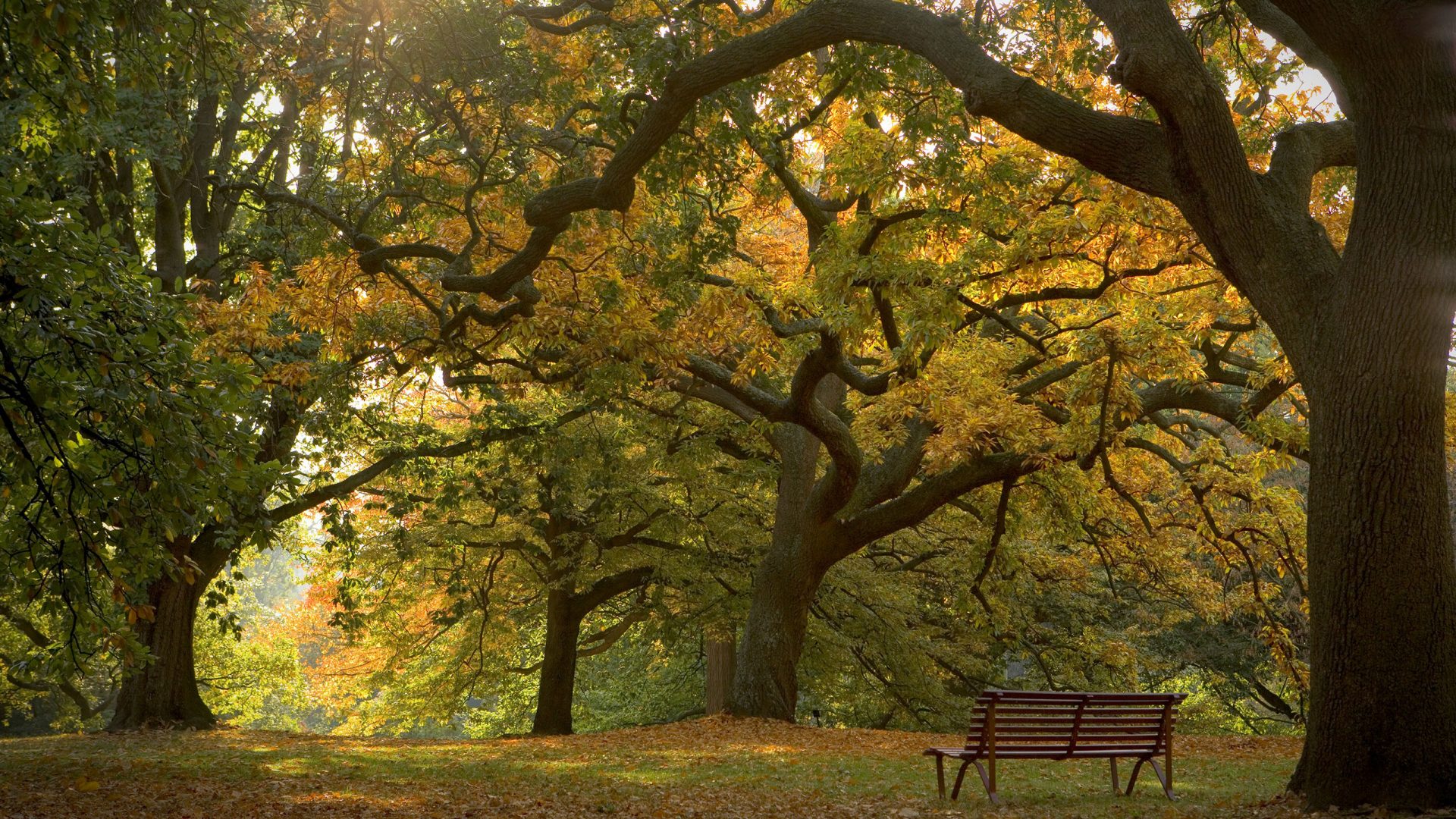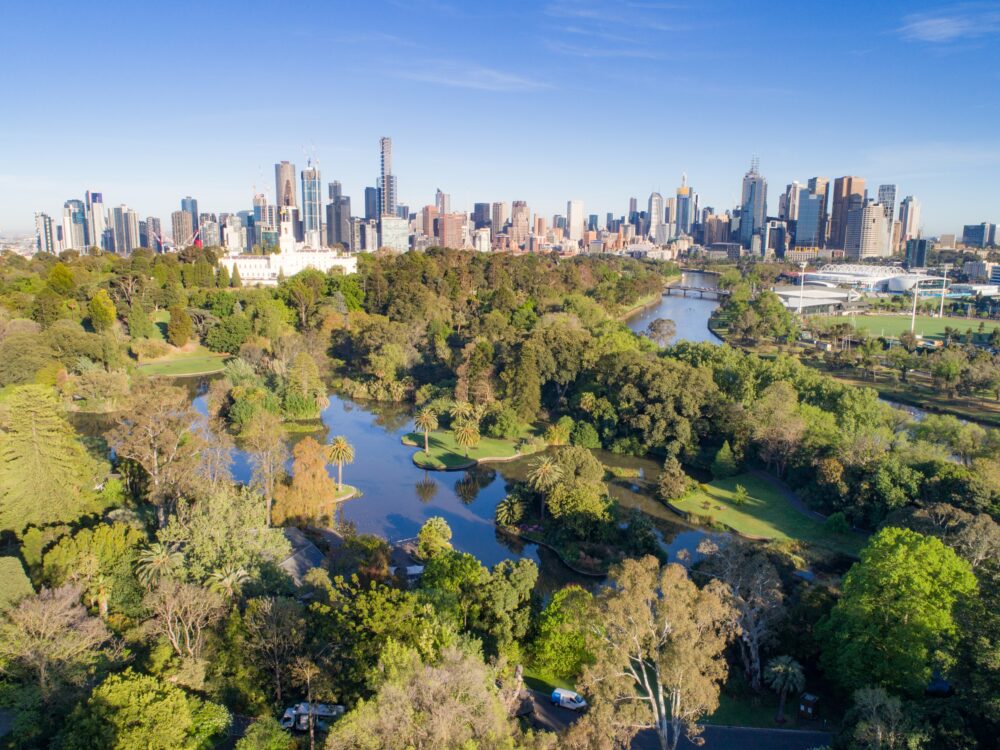Royal Botanic Gardens Victoria Melbourne Gardens, image courtesy Royal Botanic Gardens Victoria
Climate change requires adaptation not only of our landscapes, but of the way we think as individuals and organisations.
Horticulture has traditionally relied on historic observation of plant performance to inform our plant selections. When seeking a plant for a specific place and purpose, it is by using our past experience that we determine if one species is more suitable than another.
The changing climate will likely bring temperature and weather extremes that our landscapes and living collections have never experienced before: in fact the climate in which many of our older trees and landscapes were established is already gone. As this change continues, we must accept that past experience alone will not be enough to help us prepare for what is to come. But, where to start? How can you plan for a future when that future contains so much that is unknown?
This is a challenge that Royal Botanic Gardens Victoria Melbourne Gardens has been tackling for many years. The Millenium Drought required a critical reassessment of the Gardens’ water usage, which resulted in a major overhaul of the Gardens’ irrigation infrastructure and practices. An increase in the efficiency of application resulted in a reduction of water usage, and alternative sources of water were acquired to increase water security. This work took several years. When completed, what was highlighted was that drought was but one aspect of our changing climate, and that every climate challenge needed to be addressed with the same rigour if the Melbourne Gardens’ world-class landscape was to remain world-class.
This led to the 2016 publication of the Landscape Succession Strategy Melbourne Gardens 2016-2036: Adapting a world-renowned botanical landscape to climate change (LSS). This is a detailed and holistic analysis of Melbourne’s predicted future climate. It notes the specific impacts this climate would have on Melbourne Gardens’ landscapes and living collections – from water scarcity to increased temperature to a change in pest and disease behaviour to the impact on core infrastructure – and provides guidance on how best to mitigate these issues before they arise and manage them when they do. It acknowledges the particular complexities of managing plants; for the most part, they cannot be brought inside for protection against extreme weather and, past a certain size, cannot be moved to more sheltered locations or have any sort of protection built around them without severely impacting the fabric of the landscape.
The LSS provides a framework for the adaptation of the landscape by looking to scientific research for direction on how to transition plantings to ones better suited to Melbourne’s future climate. The warming and drying of Melbourne’s seasons has progressed for some decades. As this is predicted to continue, the acquisition of plants has come to specifically focus on those that have evolved in similar warm and dry climates, such as native species from the dry rainforests of northern Australia, and plants from the deserts and drylands of North America.
There will be change in the Gardens, as the palette in the landscape and living collections shifts, but a garden is never static. It is always changing and growing, reacting and healing. The purpose and character of a landscape can be maintained even if the individual parts of that landscape are altered. This is the aim of the LSS: to change the Gardens so that the Gardens remain as incredible as they are now.
Landscape Succession Toolkit
The LSS is specifically focused on Melbourne Gardens; however, the lessons learned in its development apply to all managed landscapes. The LSS was adapted to make it applicable and accessible regardless of resources or location, and this resulted in the publication of the Landscape Succession Toolkit by the Climate Change Alliance of Botanic Gardens, and Botanic Gardens Australia & New Zealand.
The Toolkit takes the daunting and frankly mammoth task of adapting to climate change and breaks the process down into manageable, bite-sized pieces, and while the practicalities of transitioning a landscape are covered in detail, perhaps the most important lesson imparted concerns the change required of us, those who bring about that transition.
Climate change is an ongoing process, and its field of research is swift-moving. What is recommended as best practice can swiftly become obsolete as our understanding develops. Rather than waiting for a singular and clear method of operation to be settled upon, we need to embrace constant learning as a necessary strength.
The insight found in the LSS and Toolkit came about not only from using predictive modelling, but from practical horticulture. Both documents are founded upon years of trial and error, as current practices are assessed against new information and improvement constantly sought. This perpetual review and renewal of methodology is now best practice. Not everything attempted will succeed, and that in itself is valuable information, informing what comes next.

Accompanying the Toolkit is the Climate Assessment Tool, which takes some of the guesswork out of selecting trees for a future climate. This is a free and publicly available online application which is very simple to use. It looks at records of where tree species are known to currently grow – within their natural distribution and also in cultivation – and the climates of those locations, and then compares those climates to the predicted future climate of the user’s selected location. This is not a foolproof determination of any tree’s tolerance for future conditions, as tempting as it is to treat it as such. Rather, climate suitability is simply another factor to consider when selecting a tree species, no different from soil preference to size, but vital for us to incorporate into our decision making. Trees form the backbone of any garden, and for what we plant today to become the green giants of the future, we must ensure that they can perform in that future.
Our gardens cannot afford to wait, and it falls to us to safeguard them so that future generations will know them as the vibrant green spaces we know them to be today.
Tessa Kum is the Landscape Succession Officer at the Royal Botanic Gardens Victoria
LINKS
Landscape Succession Strategy – https://www.rbg.vic.gov.au/initiatives/landscape-succession-strategy/
Landscape Succession Toolkit – https://www.rbg.vic.gov.au/initiatives/climate-change-alliance/landscape-succession-toolkit/
Climate Assessment Tool – http://cat.bgci.org
Climate Change Alliance of Botanic Gardens – https://www.rbg.vic.gov.au/initiatives/climate-change-alliance/
This article is one of a series prepared for a project, Antipodean historic gardens and climate change, partly funded by a grant from the international charity, the Historic Gardens Foundation.



Leave a Reply
You must be logged in as a member to post a comment.